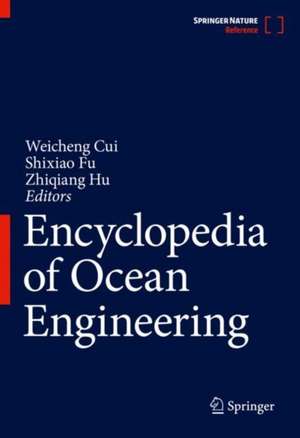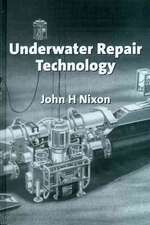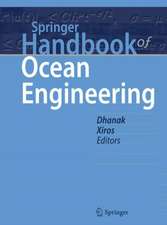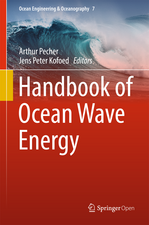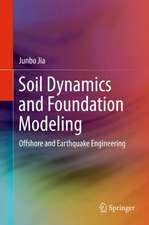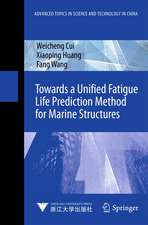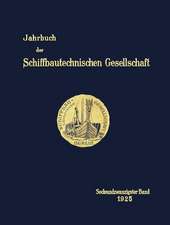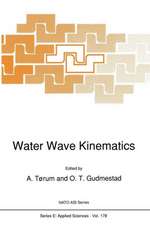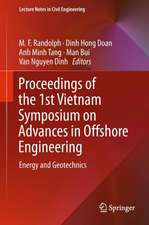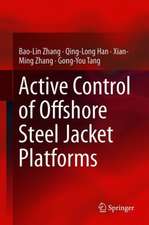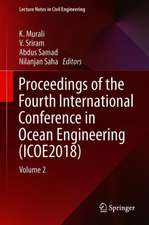Encyclopedia of Ocean Engineering: Encyclopedia of Ocean Engineering
Editat de Weicheng Cui, Shixiao Fu, Zhiqiang Huen Limba Engleză Hardback – 27 mai 2022
As the land resources approach the exploitation limit, ocean resources are becoming the next choice for the sustainable development. As such, ocean engineering is vital in the 21st century.
Preț: 5385.07 lei
Preț vechi: 6567.16 lei
-18% Nou
Puncte Express: 8078
Preț estimativ în valută:
1030.41€ • 1075.84$ • 852.81£
1030.41€ • 1075.84$ • 852.81£
Carte disponibilă
Livrare economică 15-29 martie
Preluare comenzi: 021 569.72.76
Specificații
ISBN-13: 9789811069451
ISBN-10: 981106945X
Pagini: 2177
Ilustrații: XXXIX, 2177 p. 1735 illus., 1173 illus. in color. In 3 volumes, not available separately.
Dimensiuni: 178 x 254 mm
Greutate: 5.97 kg
Ediția:1st ed. 2022
Editura: Springer Nature Singapore
Colecția Springer
Seria Encyclopedia of Ocean Engineering
Locul publicării:Singapore, Singapore
ISBN-10: 981106945X
Pagini: 2177
Ilustrații: XXXIX, 2177 p. 1735 illus., 1173 illus. in color. In 3 volumes, not available separately.
Dimensiuni: 178 x 254 mm
Greutate: 5.97 kg
Ediția:1st ed. 2022
Editura: Springer Nature Singapore
Colecția Springer
Seria Encyclopedia of Ocean Engineering
Locul publicării:Singapore, Singapore
Cuprins
Fixed and floating offshore oil and gas platforms.- Pipelines and risers.- Cables and mooring.- Buoy technology.- Foundation engineering.- Ocean mining.- Marine and offshore renewable energy.- Aquaculture engineering.- Subsea engineering.- Ship and special marine vehicle design.- Intact and damaged stability.- Technology for energy efficiency and green shipping.- Ship production technology.- Decommissioning and recycling.- Ice mechanics.- Ice-structure interaction.- Polar operations.- Polar design.- Environmental protection.- AUV/ROV/HOV design.- AUV/ROV/HOV hydrodynamics.-Maneuvering and control; and underwater-specific communicating and sensing systems for AUV/ROV/HOVs.
Notă biografică
Weicheng Cui School of Engineering Westlake University Hangzhou, Zhejiang, China
Associate Editor, Journal of Ship Mechanics, Shipbuilding of China Editorial Board Member, Marine Structures, Ocean Engineering, Ships and Offshore Structures, Journal of Marine Science and Technology, Journal ofEngineering for theMaritime Environment,JournalofMarineScienceandApplication, Journal of marine science and engineering Weicheng Cui joined Westlake University (WU) as a chair professor in September 2018, 1 month before its founding ceremony. The founding mission of WU is to become a global leaderinfrontierscientificresearchandareformer in higher education in China. Dr. Cui’s current research interests include (1) development of robotic fish-type submersibles and (2) fundamental research on the generalization of general systemtheory(GST)intotheoryofeverything(TOE) for complex systems. He got his B.Sc. from the Department of Engineering Mechanics at Tsinghua University in 1986andhisPh.D.from theUniversityofBristol, England, in 1990. From 1990 to 1993, he did his postdoctoral research in the Department of Aerospace Engineering at the University of Bristol. He made some contributions in the aspects of measurement of interlaminar shearstrength, nonlinear effect and size effect of the delamination strength, and the delamination mechanism for composite materials.
From February 1993 to May 1999, he worked at China Ship Scientific Research Center (CSSRC), and from June 1999 to September 2002, hewas appointedas theChangjiangProfessor at Shanghai Jiao Tong University. During these two periods, he mainly engaged in research in ship structural mechanics. He had made some contributions in the areas of the prediction of the ultimate strength of intact and damaged ship structures, fatigue strength assessment of ship structures, and reliability-based analysis and design of ship structures. From October 2002to March 2013, he worked at CSSRC again. Dr. Cui was the project leader and first deputy chief designer of Jiaolong deep manned submersible. He made some contributionsintheapplicationofmultidisciplinarydesign optimization method and the establishment of a rational design standard for the manned cabin. Because of his outstanding contribution to the Jiaolong manned submersible development project, he won the Blancpain Hans Hass Fifty Fathoms Award, the First Prize in National Science and Technology Progress, and many honorary titles such as “The National Excellent Science and Technology Workers,”“The Deep Diving Hero” awarded by the Central Committee and the State Council, and the first batch of scholars of the National Innovation Talent Award. From March 2013 to September 2018, he worked at Shanghai Ocean University, and from September 2018 onward, he has been working at Westlake University. He served as the project leader and chief designer of the Rainbowfish Challenging the Challenger Deep project from 2013 to 2020. In 2016, he was named one of “China’s Top Ten Science Stars” by Nature. He is currently an editorial board member of sixinternationaljournals,andtheassociateeditorin-chief of both Shipbuilding of China and the Journal of Ship Mechanics. He has published more than 400 papers in SCI and EI journals, being selected in Elsevier’s list of China’s Highly Cited Researchers continuously from 2017 to 2019.
Shixiao Fu School of Naval Architecture, Ocean and Civil Engineering Shanghai Jiao Tong University Shanghai, China
Associate Editor, Marine Structures, Journal of OffshoreMechanicsandArcticEngineering,Proceeding of the Institute of Civil Engineers-Marine Engineering Editorial Board Member, Journal of Hydrodynamics, China Ocean Engineering (in Chinese) Shixiao Fu got Bachelor and MSc degrees from DaLian University of Technology, and received his Ph.D. from Shanghai Jiao Tong University (SJTU) in 2005. In the next 2 years, he did his postdoctoral research at CeSOS, Norwegian University of Science and Technology (NTNU). He joined the faculty of Shanghai Jiao Tong Universityin2008,servedasaprofessorfrom2009to 2018, and was appointed as a distinguished professor in 2019. Professor Fu has been selected as the Academician of the Norwegian Academy of Technological Sciences in 2020, and was granted China National Funds for Distinguished Young Scientists in 2018. Professor Fu is now the vice director of the State Key Laboratory of Ocean Engineering at Shanghai Jiao Tong University, and the dean of the Research School of Polar and Deep Sea Technologies(jointresearchschoolbetweenSJTUand Second Institute of Oceanography). He is also the associate editor of Marine Structures and the Journal of Offshore Mechanics and Arctic Engineering. Professor Fu’s research interests include hydroelasticity of floating bridges/tunnels and large-scale fish cage, vortex-induced vibration of flexible structures, experimental methods of force feedback control, and hybrid full-scale model testing.
Zhiqiang Hu Marine, Offshore and Subsea Technology Group School of Engineering Newcastle University Newcastle upon Tyne, UK
Associate Editor, Ocean Engineering Zhiqiang Hu received his Ph.D. in naval architecture and oceanengineering from Shanghai Jiao Tong University in 2008 and had been working in Shanghai Jiao Tong University until 2016. He joined Newcastle University in 2016 and has been the Lloyds Professor of Offshore Engineering since 2018. Professor Hu has plenty of lecturingandresearchexperienceinoffshorerenewable energy, offshore hydrodynamics, structural dynamics,andbasinexperimenttesting.Professor Hu has published approximately 100 scientific papers and currently is the deputy editor of the journal Ocean Engineering.
Textul de pe ultima copertă
This encyclopedia adopts a wider definition for the concept of ocean engineering. Specifically, it includes (1) offshore engineering: fixed and floating offshore oil and gas platforms; pipelines and risers; cables and moorings; buoy technology; foundation engineering; ocean mining; marine and offshore renewable energy; aquaculture engineering; and subsea engineering; (2) naval architecture: ship and special marine vehicle design; intact and damaged stability; technology for energy efficiency and green shipping; ship production technology; decommissioning and recycling; (3) polar and Arctic Engineering: ice mechanics; ice-structure interaction; polar operations; polar design; environmental protection; (4) underwater technologies: AUV/ROV design; AUV/ROV hydrodynamics; maneuvering and control; and underwater-specific communicating and sensing systems for AUV/ROVs.
It summarizes the A–Z of the background and application knowledge of ocean engineering for use by ocean scientists and ocean engineers as well as nonspecialists such as engineers and scientists from all disciplines, economists, students, and politicians. Ocean engineering theories, ocean devices and equipment, ocean design and operation technologies are described by international experts, many from industry and each entry offers an introduction and references for further study, making current technology and operating practices available for future generations to learn from. The book also furthers our understanding of the current state of the art, leading to new and more efficient technologies with breakthroughs from new theory and materials.
As the land resources approach the exploitation limit, ocean resources are becoming the next choice for the sustainable development. As such, ocean engineering is vital in the 21st century.
As the land resources approach the exploitation limit, ocean resources are becoming the next choice for the sustainable development. As such, ocean engineering is vital in the 21st century.
Caracteristici
Comprehensively discusses the fundamentals and applications of ocean engineering
Offers authoritative concepts and theories
Presents the latest technological advances in the area
Offers authoritative concepts and theories
Presents the latest technological advances in the area
